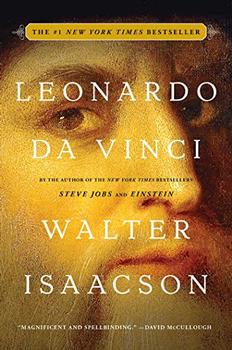Summary | Excerpt | Reviews | Beyond the Book | Readalikes | Genres & Themes | Author Bio

Critics' Opinion:
Readers' Opinion:
First Published:
Oct 2017, 624 pages
Paperback:
Oct 2018, 576 pages
 Book Reviewed by:
Book Reviewed by:
Rose Rankin
Buy This Book
With his father living mainly in Florence and his mother nurturing a growing family of her own, Leonardo by age five was primarily living in the da Vinci family home with his leisure-loving grandfather Antonio and his wife. In the 1457 tax census, Antonio listed the dependents residing with him, including his grandson: "Leonardo, son of the said Ser Piero, non legittimo, born of him and of Caterina, who is now the woman of
Achattabriga."
Also living in the household was Piero's youngest brother, Francesco, who was only fifteen years older than his nephew Leonardo. Francesco inherited a love of country leisure and was described in a tax document by his own father, in a pot-calling-the-kettle way, as "one who hangs around the villa and does nothing." He became Leonardo's beloved uncle and at times surrogate father. In the first edition of his biography, Vasari makes the telling mistake, later corrected, of identifying Piero as Leonardo's uncle.
"A GOLDEN AGE FOR BASTARDS"
As Leonardo's well-attended baptism attests, being born out of wedlock was not a cause for public shame. The nineteenth-century cultural historian Jacob Burckhardt went so far as to label Renaissance Italy "a golden age for bastards." Especially among the ruling and aristocratic classes, being illegitimate was no hindrance. Pius II, who was the pope when Leonardo was born, wrote about visiting Ferrara, where his welcoming party included seven princes from the ruling Este family, among them the reigning duke, all born out of wedlock. "It is an extraordinary thing about that family," Pius wrote, "that no legitimate heir has ever inherited the principate; the sons of their mistresses have been so much more fortunate than those of their wives." (Pius himself fathered at least two illegitimate children.) Pope Alexander VI, also during Leonardo's lifetime, had multiple mistresses and illegitimate children, one of whom was Cesare Borgia, who became a cardinal, commander of the papal armies, an employer of Leonardo, and the subject of Machiavelli's The Prince.
For members of the middle classes, however, illegitimacy was not as readily accepted. Protective of their new status, merchants and professionals formed guilds that enforced moral strictures. Although some of the guilds accepted the illegitimate sons of their members, that was not the case with the Arte dei Giuduci e Notai, the venerable (founded in 1197) guild of judges and notaries to which Leonardo's father belonged. "The notary was a certified witness and scribe," Thomas Kuehn wrote in Illegitimacy in Renaissance Florence. "His trustworthiness had to be above reproach. He had to be someone fully in the mainstream of society."
These strictures had an upside. Illegitimacy freed some imaginative and free-spirited young men to be creative at a time when creativity was increasingly rewarded. Among the poets, artists, and artisans born out of wedlock were Petrarch, Boccaccio, Lorenzo Ghiberti, Filippo Lippi, his son Filippino, Leon Battista Alberti, and of course Leonardo.
Being born out of wedlock was more complex than merely being an outsider. It created an ambiguity of status. "The problem with bastards was that they were part of the family, but not totally," wrote Kuehn. That helped some be, or forced them to be, more adventurous and improvisational. Leonardo was a member of a middle-class family but separate from it. Like so many writers and artists, he grew up feeling a part of the world but also detached. This limbo extended to inheritance: a combination of conflicting laws and contradictory court precedents left it unclear whether a son born out of wedlock could be an heir, as Leonardo was to find out in legal battles with his stepbrothers many years later. "Management of such ambiguities was one of the hallmarks of life in a Renaissance city-state," explained Kuehn. "It was related to the more celebrated creativity of a city like Florence in the arts and humanism."
Excerpted from Leonardo da Vinci by Walter Isaacson. Copyright © 2017 by Walter Isaacson. Excerpted by permission of Simon & Schuster. All rights reserved. No part of this excerpt may be reproduced or reprinted without permission in writing from the publisher.





The House on Biscayne Bay
by Chanel Cleeton
As death stalks a gothic mansion in Miami, the lives of two women intertwine as the past and present collide.

The Flower Sisters
by Michelle Collins Anderson
From the new Fannie Flagg of the Ozarks, a richly-woven story of family, forgiveness, and reinvention.

The Funeral Cryer by Wenyan Lu
Debut novelist Wenyan Lu brings us this witty yet profound story about one woman's midlife reawakening in contemporary rural China.
Your guide toexceptional books
BookBrowse seeks out and recommends the best in contemporary fiction and nonfiction—books that not only engage and entertain but also deepen our understanding of ourselves and the world around us.